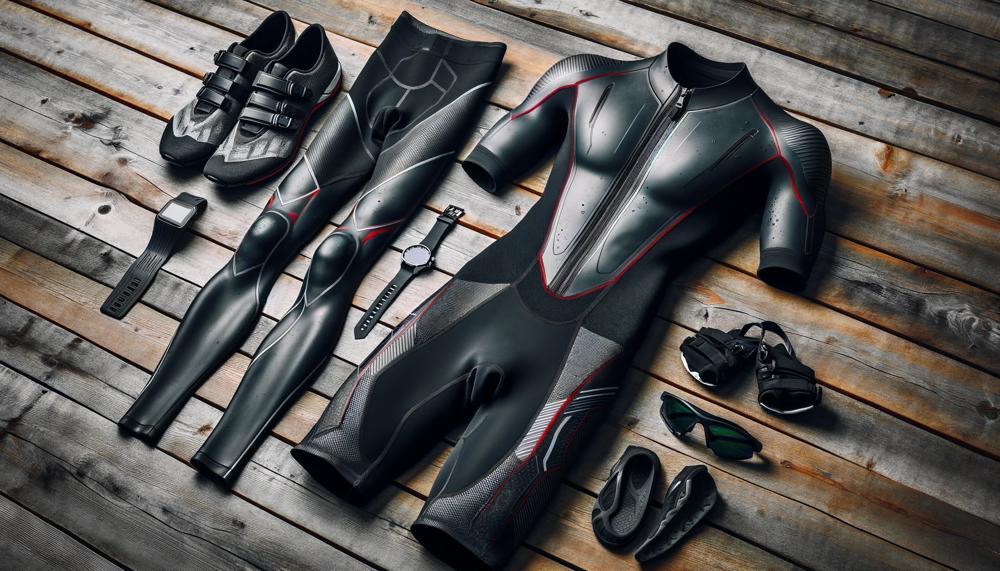Diving into the world of triathlon can be as thrilling as it is demanding, especially when it comes to selecting the right gear.
Among the plethora of choices, deciding what to wear under a wetsuit for a triathlon stands out as a crucial decision that can significantly impact your comfort and performance.
This blog post aims to shed light on the essential undergarments that triathletes should consider to ensure they stay focused on the race, not on their gear.
We’ll explore the delicate balance between comfort, functionality, and speed in transitions, guiding you through options that promise to keep chafing at bay while enhancing your swimming efficiency.

From the streamlined, quick-drying tri-suits to specialized undergarments designed for cold water conditions, we’ll cover all you need to know to make an informed decision. Here are the major takeaways:
- The importance of material selection for comfort and quick drying.
- Design features that facilitate speedy transitions.
- Options for different water temperatures, ensuring you’re prepared for any conditions.
Whether you’re a seasoned triathlete or new to the sport, understanding what to wear under your wetsuit is key to a seamless experience.
Let’s dive in and ensure that your focus remains on reaching the finish line, comfortably and efficiently.
Table of Contents
What to Wear Under a Triathlon Wetsuit
Choosing the right attire to don beneath a triathlon wetsuit is a game changer for enhancing performance and comfort throughout the race. Here’s a straightforward guide:
| Clothing Option | Benefits | Considerations |
| Tri Suit (One-piece) | Seamless transition between swim, bike, and run; quick-drying; reduces chafing. | Trickier for bathroom stops; must fit perfectly to avoid restriction. |
| Tri Suit (Two-piece) | Flexibility in fit; easier for bathroom breaks; quick-drying. | Can shift during performance if not well-fitted. |
| Compression Garments | Supports muscles; reduces fatigue; quick-drying. | Not specifically designed for triathlons; may lack convenience features of tri suits. |
| Swimwear | Simple; works under a wetsuit. | Requires change for bike and run segments; less supportive. |
| Sports Bra (for women) | Additional support and comfort under a tri suit. | Choose a quick-drying material to prevent chafing. |
So, whether you’re a fresh face in the triathlon scene or a seasoned veteran looking to refine your gear, picking the right layers under your wetsuit is pivotal. Not only does it affect your performance in the water, but it also plays a crucial role in your overall race day experience.
Diving into Alternatives: Options Beyond the Tri Suit
When it comes to triathlon apparel, the right clothing choices can make a significant difference in both comfort and performance.
While one-piece tri suits are a popular choice for their convenience and aerodynamic benefits, there are alternative options for athletes seeking versatility or specific features.
| Option | Benefits | Considerations |
| Two-Piece Tri Suits | Flexibility, ease of use | Fit, comfort |
| Cycling Jerseys and Shorts | Comfort, padding | Bulkiness, transition time |
| Compression Wear | Support, circulation | Tightness, heat retention |
| Sports Bras | Support, quick-drying | Comfort, fit |
| Swimskins | Hydrodynamic, performance | Non-wetsuit races, fit |
| Triathlon-Specific Undergarments | Comfort, chafing prevention | Material, seams |
In summary, while the one-piece tri suit remains a popular choice for its streamlined benefits, exploring alternative clothing options allows triathletes to tailor their race day attire to their specific needs and preferences.
Other Factors to Consider
When delving into what to wear under a wetsuit during a triathlon, material and fabric selection are paramount for ensuring comfort, performance, and, let’s be honest, a bit of sanity in those chilly waters. Here’s the lowdown, tailored for those with a penchant for the triathlon buzz.
Material Matters:
Neoprene: A no-brainer for its heat-trapping prowess, offering a snug layer of warmth beneath your wetsuit.
Lycra or Spandex: Stellar for its stretch, sticking to your skin like a second layer without chafing or restricting your superhero moves.
Gender-Specific Choices:
- Men: Swim trunks or board shorts, though ensure they’re close-fitting to avoid any unwelcome drag.
- Women: A trusty swimsuit or bikini that clings, yet gives, allowing full freedom without the fuss.
All-Weather Allies:
- Rash Guards: The unsung heroes, saving your skin from the sun’s glare and the wetsuit’s rub.
- Neoprene Shorts or Pants: For those colder currents, adding a layer without bulking you out.
Feet First:
- Neoprene Socks: A small addition with big benefits, keeping toes toasty and fend off the nibbles from unseen seabed critters.
What I Wore to my First Triathlon
When I embarked on my first triathlon, the choice of what to wear beneath my wetsuit was a decision I weighed with great care. This choice is pivotal, not merely for the sake of comfort but also for the seamless execution of the race itself, impacting both speed and endurance.
Essential Undergarments for Triathlon Performance
| Item | Benefits | Material |
| Tri Suit (One-Piece or Two-Piece) | Facilitates quick transitions, reduces drag in water, provides muscle compression, and offers sun protection. | Quick-drying fabric (Polyamide, Lycra, or Polyester) |
| Sports Bra (for females) | Ensures support, reduces discomfort, and prevents excessive sweating. | Moisture-wicking fabric |
| Neoprene Socks | Protects feet from cold and blisters during the swim. | Neoprene |
Tri Suit: The Cornerstone of Triathlon Gear
The tri suit, a quintessential piece, plays a crucial role. Whether opting for a one-piece or a two-piece, this garment is designed to be worn underneath the wetsuit, streamlining transitions from swim to bike to run. Its quick-drying capabilities are paramount, ensuring that the athlete does not remain soaked post-swim, which could lead to discomfort or chafing during the bike and run segments.
A well-fitting tri suit offers muscle compression, which can enhance blood flow and reduce fatigue, allowing for an efficient and comfortable race. Moreover, the choice between sleeved and sleeveless should be made with weather and protection in mind; sleeves offer additional coverage against the sun and elements, while sleeveless options might be preferred in hotter conditions but with caution regarding potential chafing and sunburn.
Choosing the Right Fit and Material
The importance of the material cannot be overstated – it should be of a nature that wicks away moisture, dries rapidly, and remains breathable throughout the race.
The fit is equally vital; too tight, and it may restrict movement or cause discomfort; too loose, and it could create drag during the swim or catch wind on the bike, slowing down the athlete.
Pre-Race Testing Is Key
An often overlooked but critical aspect is the necessity of testing one’s gear well before race day. This ensures that the chosen clothing does not cause chafing, discomfort, or any unforeseen issues, allowing the athlete to focus solely on the race ahead.
Conclusion
In the world of triathlon, every second counts and comfort is king. As we’ve explored in this comprehensive guide, the right gear beneath your wetsuit is not just about warmth and modesty; it’s a strategic decision that influences your overall performance and transition speed.
For triathletes, the tri suit reigns supreme, offering a seamless shift between swimming, biking, and running. Whether you choose a one-piece for its aerodynamic advantage or a two-piece for its comfort and convenience, these suits are the gold standard in under-wetsuit attire. They excel in reducing drag in the water and speeding up transitions, all while keeping chafing at bay.
But there’s more to this sartorial puzzle. Compression garments and swimwear offer alternative solutions, each with its unique set of benefits and compromises. Compression wear supports muscle stability, while basic swimwear keeps things simple, though they may not offer the comprehensive advantages of a tri suit.
Let’s not forget the importance of the right material – look for quick-drying, moisture-wicking fabrics to maintain comfort throughout the race. And for the ladies, a sports bra that’s both supportive and quick-drying is a must to stay focused and comfortable.
Above all, remember the mantra of every seasoned triathlete: nothing new on race day. Test your chosen attire during training to ensure it meets the demands of your race.






